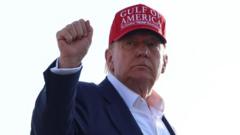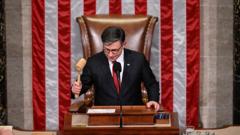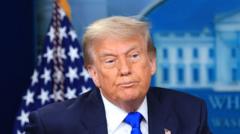In a significant electoral victory, Prime Minister Mark Carney has managed to secure another term in office for the Liberal Party, overcoming the odds as external political factors shifted the landscape.
Mark Carney Secures New Term as Canada’s Prime Minister

Mark Carney Secures New Term as Canada’s Prime Minister
In a dramatic election result, Prime Minister Mark Carney retains leadership in Canada amidst external pressures.
Mark Carney, Prime Minister of Canada, celebrated an unexpected electoral victory on April 28, as reported by national broadcaster CBC/Radio Canada. His triumph is largely attributed to the influential role of former President Donald Trump’s controversial policies, which have stirred Canadian political dynamics and reinvigorated support for the Liberal Party as they vie for a new term in the House of Commons.
Recent months saw the Conservative Party, under Pierre Poilievre, poised for victory. However, Trump’s aggressive strategies towards Canada—including imposing stiff tariffs that threatened economic stability—have painted the Conservatives in a negative light, compelling voters to rally behind Carney’s leadership. As the situation stands, it remains unclear whether the Liberal Party has secured a majority in Parliament or will require a coalition for governance.
Carney, who has portrayed himself as a bastion against Trump’s divisive politics, leverages his extensive background in economics, having previously served as the governor of both the Bank of Canada and the Bank of England during tumultuous times. This election underscored the risks posed to conservative factions globally when tying their identity too closely to Trump’s controversial reputation and ideologies.
Meanwhile, Poilievre’s attempts to cater to a right-leaning electorate by critiquing "woke ideology" and advocating for cuts to the national broadcaster and foreign aid have reportedly alienated centrist voters, contributing to Carney's electoral resurgence.
As political analysts digest the implications of this election result, the landscape ahead for Canadian governance will highly depend on how well the Liberal Party can navigate the potential challenges ahead, especially in the wake of Trump’s ongoing influence on Canadian politics.
Recent months saw the Conservative Party, under Pierre Poilievre, poised for victory. However, Trump’s aggressive strategies towards Canada—including imposing stiff tariffs that threatened economic stability—have painted the Conservatives in a negative light, compelling voters to rally behind Carney’s leadership. As the situation stands, it remains unclear whether the Liberal Party has secured a majority in Parliament or will require a coalition for governance.
Carney, who has portrayed himself as a bastion against Trump’s divisive politics, leverages his extensive background in economics, having previously served as the governor of both the Bank of Canada and the Bank of England during tumultuous times. This election underscored the risks posed to conservative factions globally when tying their identity too closely to Trump’s controversial reputation and ideologies.
Meanwhile, Poilievre’s attempts to cater to a right-leaning electorate by critiquing "woke ideology" and advocating for cuts to the national broadcaster and foreign aid have reportedly alienated centrist voters, contributing to Carney's electoral resurgence.
As political analysts digest the implications of this election result, the landscape ahead for Canadian governance will highly depend on how well the Liberal Party can navigate the potential challenges ahead, especially in the wake of Trump’s ongoing influence on Canadian politics.





















